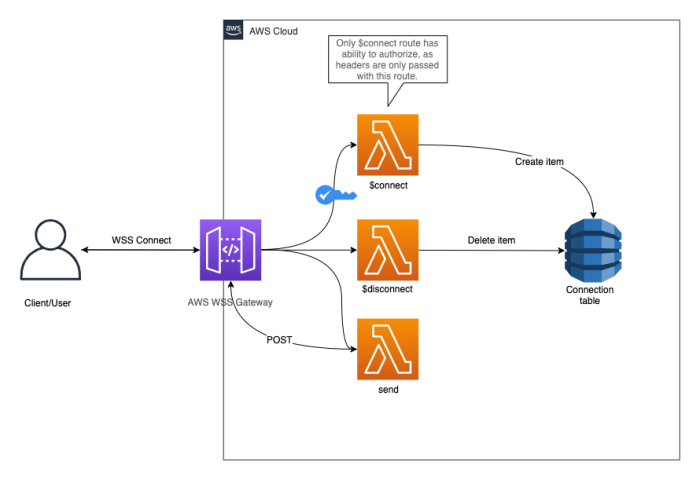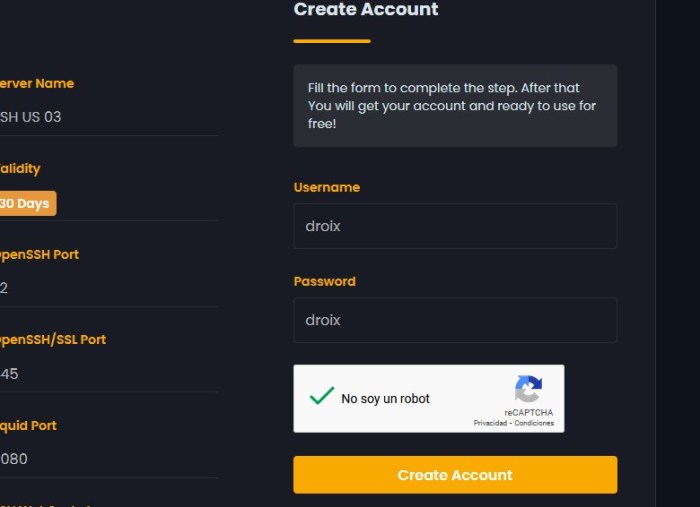SSH.SSHSlowdns.com – In the realm of secure remote connectivity, SSH (Secure Shell) has long been a trusted protocol. However, with the advent of modern web technologies, the need for SSH connections that seamlessly integrate with web applications has become increasingly apparent. This is where SSH WebSockets come into play, offering a unique blend of security and flexibility.
SSH WebSockets establish a secure, real-time communication channel between a web browser and a remote server, enabling interactive terminal sessions, remote device management, and secure data transfer. In this comprehensive guide, we will delve into the intricacies of creating and utilizing SSH WebSockets, empowering you to leverage their capabilities for a wide range of remote connectivity scenarios.
Secure SSH WebSocket Connections
Securing SSH WebSocket connections is essential to ensure the privacy and integrity of data transmitted over the network. SSH (Secure Shell) provides a secure channel for remote login and command execution, and when combined with WebSocket, it enables real-time communication over a persistent connection.
However, it is crucial to implement encryption and authentication mechanisms to safeguard SSH WebSocket connections from eavesdropping and unauthorized access.
Encryption Mechanisms
Encryption is the foundation of secure SSH WebSocket connections. It involves encrypting data before sending it over the network, making it unreadable to unauthorized parties. SSH WebSocket servers should implement strong encryption algorithms, such as AES-256 or ChaCha20, to protect data in transit.
Authentication and Authorization
Authentication and authorization are critical for controlling access to SSH WebSocket servers. Authentication verifies the identity of users attempting to connect, while authorization determines their access privileges. SSH WebSocket servers should employ robust authentication methods, such as public-key cryptography or two-factor authentication, to prevent unauthorized access.
Authorization can be implemented using access control lists (ACLs) or role-based access control (RBAC) to restrict user access to specific resources or commands.
Use Cases for SSH WebSockets

SSH WebSockets offer a secure and convenient way to establish remote connections over the web. They find applications in various domains, including:
Remote terminal access: SSH WebSockets enable secure access to remote servers and devices, allowing users to execute commands, manage files, and troubleshoot issues remotely. This is particularly useful for system administrators, developers, and IT support personnel.
Device management: SSH WebSockets can be used to manage and configure network devices, such as routers, switches, and firewalls. This allows network administrators to perform tasks like firmware updates, configuration changes, and remote monitoring from a centralized location.
Secure data transfer: SSH WebSockets provide a secure channel for transferring sensitive data over the internet. This is useful for applications such as secure file sharing, remote backups, and data synchronization.
Real-World Examples
- Cloud providers like Amazon Web Services (AWS) and Microsoft Azure offer SSH WebSockets as a service, enabling users to securely access and manage their cloud resources remotely.
- Network management tools like SolarWinds Network Performance Monitor and ManageEngine OpManager utilize SSH WebSockets for remote device management and monitoring.
- DevOps teams use SSH WebSockets to automate software deployment and configuration management tasks on remote servers.
Advantages and Limitations
Advantages of using SSH WebSockets include:
- Secure connections: SSH WebSockets encrypt data transmission, ensuring confidentiality and integrity.
- Cross-platform compatibility: SSH WebSockets can be used on various platforms and devices, including Windows, macOS, Linux, and mobile devices.
- Real-time communication: SSH WebSockets support real-time data exchange, enabling interactive remote sessions and remote device management.
Limitations of SSH WebSockets include:
- Network latency: SSH WebSockets rely on network connectivity, and high latency can impact performance.
- Firewall restrictions: Firewalls may need to be configured to allow SSH WebSocket connections.
- Security considerations: SSH WebSockets should be implemented with proper security measures, such as strong encryption and authentication mechanisms.
Comparison of SSH WebSocket Libraries

SSH WebSocket libraries provide a convenient and secure way to establish SSH connections over a WebSocket protocol. Several popular libraries are available, each with its unique features and capabilities. This section compares the three widely used SSH WebSocket libraries: SockJS, Primus, and WebSocket++.
The table below summarizes the key features, performance, and compatibility aspects of each library:
| Feature | SockJS | Primus | WebSocket++ |
|---|---|---|---|
| WebSocket Support | Yes | Yes | Yes |
| SSH Support | Yes | Yes | Yes |
| Cross-Platform Compatibility | Windows, Linux, macOS | Windows, Linux, macOS | Windows, Linux, macOS |
| Event-Driven Architecture | Yes | Yes | Yes |
| Performance | Good | Excellent | Excellent |
| Documentation | Comprehensive | Good | Excellent |
Pros and Cons of Each Library
SockJS:
- Pros: Cross-platform compatibility, supports various transport mechanisms (WebSocket, HTTP long-polling, etc.).
- Cons: May have higher latency compared to other libraries.
Primus:
- Pros: Excellent performance, customizable event handling.
- Cons: Limited cross-platform compatibility (Windows only).
WebSocket++:
- Pros: High performance, extensive documentation, supports multiple protocols (WebSocket, SSH, etc.).
- Cons: Can be complex to set up and configure.
Performance Considerations for SSH WebSockets

Utilizing SSH WebSockets introduces performance implications that warrant careful consideration. Understanding these factors is crucial for optimizing the performance of SSH WebSocket connections.
The performance of SSH WebSocket connections is influenced by various factors, including:
Network Latency
Network latency refers to the time taken for data packets to traverse the network. High latency can result in noticeable delays in communication between the client and server, impacting the overall responsiveness of the SSH WebSocket connection.
Data Volume
The volume of data being transferred over the SSH WebSocket connection can significantly impact performance. Large data transfers, such as file uploads or downloads, can consume significant bandwidth and lead to performance bottlenecks.
Encryption Overhead
SSH WebSockets rely on encryption to ensure secure communication. However, encryption introduces an overhead that can affect performance. The choice of encryption algorithm and key length can influence the computational cost and impact the overall speed of the connection.
Client and Server Hardware
The hardware capabilities of the client and server can also affect the performance of SSH WebSocket connections. Limited processing power or memory on either end can result in performance degradation.
Troubleshooting SSH WebSocket Issues
Establishing and maintaining SSH WebSocket connections can occasionally encounter challenges. This section delves into common issues and provides troubleshooting guides to resolve them effectively.
Identifying Common Issues
Several factors can contribute to SSH WebSocket issues, including:
- Network connectivity problems
- Firewall or security restrictions
- Incorrect configuration or setup
- Server-side issues
Troubleshooting Steps
To troubleshoot SSH WebSocket connection problems, follow these steps:
- Check network connectivity: Ensure that the client and server can communicate over the network. Use tools like ping or traceroute to verify connectivity.
- Review firewall settings: Check if firewalls on the client or server are blocking the SSH WebSocket connection. Ensure that the appropriate ports are open.
- Verify configuration: Examine the SSH WebSocket library configuration to ensure it matches the server settings. Check the hostname, port, and authentication credentials.
- Inspect server logs: If the connection fails, check the server logs for error messages that may indicate the cause of the issue.
- Use debugging tools: Some SSH WebSocket libraries provide debugging tools to help identify connection problems. Enable debugging to capture detailed error messages.
Debugging Tips
To debug SSH WebSocket errors, consider the following tips:
- Use a network sniffer: Capture network traffic to analyze the connection attempts and identify any issues with packet exchange.
- Enable verbose logging: Set the logging level to verbose to obtain more detailed error messages.
- Check for memory leaks: If the connection hangs or crashes, check for memory leaks in the SSH WebSocket library or the application using it.
Future of SSH WebSockets
SSH WebSockets are poised to revolutionize remote connectivity, with their ability to provide secure, real-time, and browser-based access to remote systems. As technology advances, we can expect to see even more innovative applications and use cases for SSH WebSockets.One of the most exciting trends in SSH WebSocket technology is the development of new and improved encryption algorithms.
These algorithms will make it even more difficult for attackers to eavesdrop on or intercept SSH WebSocket connections, ensuring the privacy and security of sensitive data.Another promising development is the integration of SSH WebSockets with other technologies, such as artificial intelligence (AI) and machine learning (ML).
This integration will enable SSH WebSockets to perform more complex tasks, such as automated system management and security monitoring.In the future, SSH WebSockets are likely to become even more widely adopted by businesses and organizations of all sizes. This is because SSH WebSockets offer a number of advantages over traditional SSH connections, including:
- Increased security
- Improved performance
- Browser-based access
- Reduced costs
As SSH WebSocket technology continues to evolve, we can expect to see even more innovative applications and use cases for this powerful tool. SSH WebSockets are poised to become the future of remote connectivity, providing a secure, real-time, and convenient way to access remote systems from anywhere in the world.
SSH WebSocket Resources
To further explore the world of SSH WebSockets, an array of valuable resources awaits you, from comprehensive tutorials and detailed documentation to a thriving open-source community. These resources cater to diverse needs, whether you seek to delve into the technical intricacies of SSH WebSocket development or connect with like-minded individuals for support and collaboration.
The following table provides a curated list of resources, categorized according to their relevance to various aspects of SSH WebSocket development: